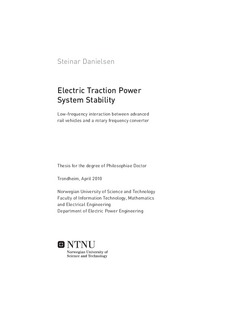| dc.contributor.advisor | Fosso, Olav Bjarte | nb_NO |
| dc.contributor.advisor | Toftevaag, Trond | nb_NO |
| dc.contributor.advisor | Molinas, Marta | nb_NO |
| dc.contributor.author | Danielsen, Steinar | nb_NO |
| dc.date.accessioned | 2014-12-19T13:50:46Z | |
| dc.date.available | 2014-12-19T13:50:46Z | |
| dc.date.created | 2010-04-04 | nb_NO |
| dc.date.issued | 2010 | nb_NO |
| dc.identifier | 319110 | nb_NO |
| dc.identifier.isbn | ISBN 978-82-471-2069-9 | nb_NO |
| dc.identifier.isbn | ISBN 978-82-471-2068-2 | nb_NO |
| dc.identifier.uri | http://hdl.handle.net/11250/256435 | |
| dc.description.abstract | Low-frequency instability in AC electric traction power systems has come to be a concern in recent years. Power oscillations in the range of 10-30 % of the system’s fundamental frequency are reported from all over the world after the introduction of large numbers of rail vehicles being equipped with modern power electronic traction chain solutions. The disturbance of rail traffic has been especially noticeable in Norway, where the railway power supply contains rotary frequency converters which show a poorly damped electromechanical eigenfrequency of approximately 1.6 Hz.
The overall goal of the present thesis is to acquire knowledge concerning stability in the traction power system, focusing mainly on the low-frequency oscillations and interaction between electric rail vehicles and this particular rotary converter. An important part of this work is to establish a connection between the fields of both power electronics and power system analysis.
The problem is approached by the development and study of basic differential equations and characteristics for the two main dynamical components in the system – the synchronous-synchronous rotary frequency converter and the advanced electric rail vehicle. These simplified models are used to obtain a better understanding of the dynamical behaviour of a full converter-vehicle simulation model which is studied by the use of both time simulations and linear analysis (eigenvalues and frequency responses). The developed vehicle model is open and independent of any specific vehicle manufacturer. The model’s basic validity however is investigated by comparison with measurements performed on a real-life electric rail vehicle.
This thesis focuses on the small-signal behaviour of the power system in the mentioned low-frequency range. Detailed analytical investigations of the complex single-phase AC power system is difficult, thus most of the analytical studies in present thesis focusing on the active power oscillations are carried out by several simplifications. The largest simplification is the assumption of the AC voltage and current in phase and only considering their amplitude values. This is useful for initial understanding, but is insufficient when phase angles are to be taken into account.
Therefore the simplified analytical considerations by principle are compared with the complete AC power system model in a rotating reference frame as commonly utilised for large power systems. However, for this full simulation model it has been found that traditional power system simplifications by use of standard RMS-values are insufficient in correctly representing the instability phenomenon compared with a more realistic instantaneous value model. Fast network dynamics and vehicle current controller which are commonly neglected, have to be included as well and consequently an enhanced RMS model is proposed.
Two characteristics of the state-of-the-art electric rail vehicle are found to be of importantance. First, a control objective of the vehicle is to keep the power consumption constant and independent of the power supply conditions. This constant power load characteristic is shown to result in a positive feedback loop and basically violate a stability criterion derived for the rotary converter. Second, the time variance of a single-phase system results in several filter time constants giving dynamics in the low-frequency range. Of particular importance is the DC-link voltage control loop. These dynamics might additionally reduce the stability margins.
This study’s main contribution is as a foundation for further investigation into low-frequency traction power system stability, especially in regard to the open vehicle model that is developed and discussed. A further focus should be on an understanding of more of the aspects of the AC system interaction and how to include this in a feasible method for power system study, in which the inner and commonly hidden details of the complex components are included, although not specifically disclosed. | nb_NO |
| dc.language | eng | nb_NO |
| dc.publisher | Norges teknisk-naturvitenskapelige universitet | nb_NO |
| dc.relation.ispartofseries | Doktoravhandlinger ved NTNU, 1503-8181; 2010:56 | nb_NO |
| dc.subject | stability | en_GB |
| dc.subject | railway | en_GB |
| dc.subject | traction power system | en_GB |
| dc.subject | rail vehicle | en_GB |
| dc.subject | locomotive | en_GB |
| dc.subject | train | en_GB |
| dc.subject | linear analysis | en_GB |
| dc.subject | eigenvalues | en_GB |
| dc.subject | input admittance | en_GB |
| dc.title | Electric Traction Power System Stability: Low-frequency interaction between advanced rail vehicles and a rotary frequency converter | nb_NO |
| dc.type | Doctoral thesis | nb_NO |
| dc.source.pagenumber | 245 | nb_NO |
| dc.contributor.department | Norges teknisk-naturvitenskapelige universitet, Fakultet for informasjonsteknologi, matematikk og elektroteknikk, Institutt for elkraftteknikk | nb_NO |
| dc.description.degree | PhD i elektronteknikk | nb_NO |
| dc.description.degree | PhD in Electrical Engineering | en_GB |
